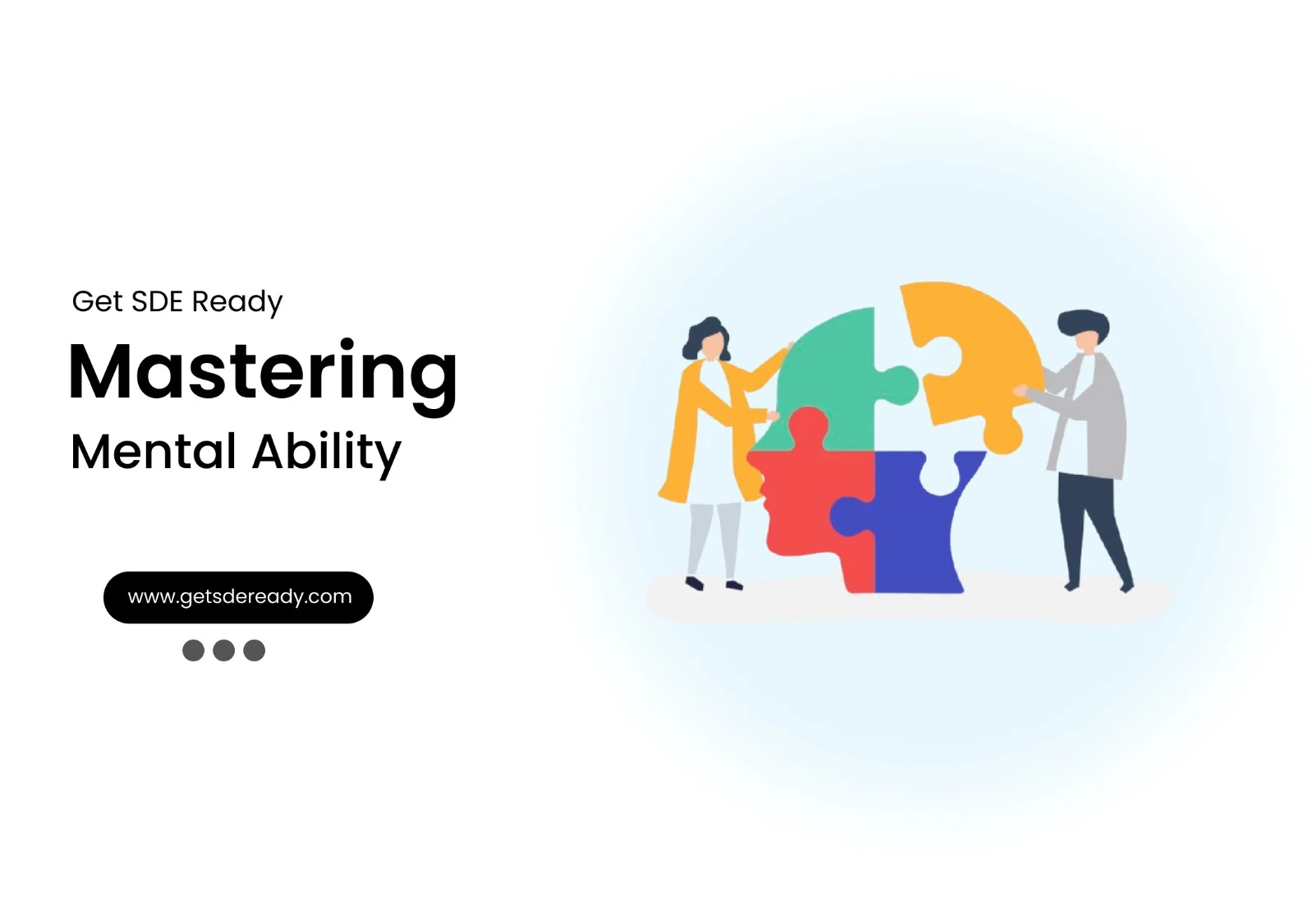Data Structures and Algorithms
- Introduction to Data Structures and Algorithms
- Time and Space Complexity Analysis
- Big-O, Big-Theta, and Big-Omega Notations
- Recursion and Backtracking
- Divide and Conquer Algorithm
- Dynamic Programming: Memoization vs. Tabulation
- Greedy Algorithms and Their Use Cases
- Understanding Arrays: Types and Operations
- Linear Search vs. Binary Search
- Sorting Algorithms: Bubble, Insertion, Selection, and Merge Sort
- QuickSort: Explanation and Implementation
- Heap Sort and Its Applications
- Counting Sort, Radix Sort, and Bucket Sort
- Hashing Techniques: Hash Tables and Collisions
- Open Addressing vs. Separate Chaining in Hashing
- DSA Questions for Beginners
- Advanced DSA Questions for Competitive Programming
- Top 10 DSA Questions to Crack Your Next Coding Test
- Top 50 DSA Questions Every Programmer Should Practice
- Top Atlassian DSA Interview Questions
- Top Amazon DSA Interview Questions
- Top Microsoft DSA Interview Questions
- Top Meta (Facebook) DSA Interview Questions
- Netflix DSA Interview Questions and Preparation Guide
- Top 20 DSA Interview Questions You Need to Know
- Top Uber DSA Interview Questions and Solutions
- Google DSA Interview Questions and How to Prepare
- Airbnb DSA Interview Questions and How to Solve Them
- Mobile App DSA Interview Questions and Solutions
DSA Interview Questions
- DSA Questions for Beginners
- Advanced DSA Questions for Competitive Programming
- Top 10 DSA Questions to Crack Your Next Coding Test
- Top 50 DSA Questions Every Programmer Should Practice
- Top Atlassian DSA Interview Questions
- Top Amazon DSA Interview Questions
- Top Microsoft DSA Interview Questions
- Top Meta (Facebook) DSA Interview Questions
- Netflix DSA Interview Questions and Preparation Guide
- Top 20 DSA Interview Questions You Need to Know
- Top Uber DSA Interview Questions and Solutions
- Google DSA Interview Questions and How to Prepare
- Airbnb DSA Interview Questions and How to Solve Them
- Mobile App DSA Interview Questions and Solutions
Data Structures and Algorithms
- Introduction to Data Structures and Algorithms
- Time and Space Complexity Analysis
- Big-O, Big-Theta, and Big-Omega Notations
- Recursion and Backtracking
- Divide and Conquer Algorithm
- Dynamic Programming: Memoization vs. Tabulation
- Greedy Algorithms and Their Use Cases
- Understanding Arrays: Types and Operations
- Linear Search vs. Binary Search
- Sorting Algorithms: Bubble, Insertion, Selection, and Merge Sort
- QuickSort: Explanation and Implementation
- Heap Sort and Its Applications
- Counting Sort, Radix Sort, and Bucket Sort
- Hashing Techniques: Hash Tables and Collisions
- Open Addressing vs. Separate Chaining in Hashing
- DSA Questions for Beginners
- Advanced DSA Questions for Competitive Programming
- Top 10 DSA Questions to Crack Your Next Coding Test
- Top 50 DSA Questions Every Programmer Should Practice
- Top Atlassian DSA Interview Questions
- Top Amazon DSA Interview Questions
- Top Microsoft DSA Interview Questions
- Top Meta (Facebook) DSA Interview Questions
- Netflix DSA Interview Questions and Preparation Guide
- Top 20 DSA Interview Questions You Need to Know
- Top Uber DSA Interview Questions and Solutions
- Google DSA Interview Questions and How to Prepare
- Airbnb DSA Interview Questions and How to Solve Them
- Mobile App DSA Interview Questions and Solutions
DSA Interview Questions
- DSA Questions for Beginners
- Advanced DSA Questions for Competitive Programming
- Top 10 DSA Questions to Crack Your Next Coding Test
- Top 50 DSA Questions Every Programmer Should Practice
- Top Atlassian DSA Interview Questions
- Top Amazon DSA Interview Questions
- Top Microsoft DSA Interview Questions
- Top Meta (Facebook) DSA Interview Questions
- Netflix DSA Interview Questions and Preparation Guide
- Top 20 DSA Interview Questions You Need to Know
- Top Uber DSA Interview Questions and Solutions
- Google DSA Interview Questions and How to Prepare
- Airbnb DSA Interview Questions and How to Solve Them
- Mobile App DSA Interview Questions and Solutions
Top 5 Mistakes to Avoid in Coding Interviews
Landing a job in tech often hinges on nailing the coding interview, but even the most skilled programmers can stumble if they’re not careful. If you’re preparing for your next big opportunity, avoiding common pitfalls is key to standing out. To get started with free resources and the latest updates on interview prep strategies, sign up for our exclusive coding interview newsletter – it’s packed with tips to help you succeed.
In this comprehensive guide, we’ll dive deep into the top 5 mistakes candidates make during coding interviews. Drawing from expert insights, real-world data, and proven strategies, we’ll explore why these errors happen, their impact, and how you can sidestep them. Whether you’re a fresh graduate or a seasoned developer switching roles, understanding these can dramatically boost your chances. According to industry reports, approximately 80% of candidates fail coding interviews not because of a lack of technical knowledge, but due to preventable mistakes. We’ll back this up with statistics, quotes from recruiters and engineers, and actionable advice to make your preparation more effective.
Coding interviews aren’t just about writing code; they’re about demonstrating problem-solving, communication, and efficiency under pressure. Sites like LeetCode and HackerRank are great for practice, but real success comes from holistic preparation. Let’s break it down.
Why Avoiding These Mistakes Matters
Before we jump into the specifics, consider the stakes. A single coding interview can determine whether you land a role at top companies like Google, Amazon, or Meta. Data from platforms like interviewing.io, which analyzed thousands of technical interviews, shows that common errors like poor communication or ignoring edge cases account for a significant portion of rejections. In fact, in one study of over 10,000 interviews, candidates who communicated their thought process clearly were 2.5 times more likely to receive an offer.
These mistakes aren’t just theoretical – they’re drawn from real experiences shared by engineers on forums like Reddit and LinkedIn, as well as expert analyses from sites like Design Gurus and AlgoCademy. By addressing them, you’ll not only solve problems better but also showcase the soft skills employers value. If you’re looking to build a strong foundation, our DSA course can help you master the algorithms that often trip people up.
Mistake 1: Not Clarifying the Problem Fully
One of the most frequent blunders in coding interviews is diving headfirst into solving a problem without fully understanding it. This happens because candidates are eager to impress and start coding right away, but it often leads to misguided solutions that don’t address the core requirements.
Why It’s a Mistake
Rushing without clarification can result in code that works for basic cases but fails on specifics the interviewer had in mind. As one ex-Google engineer noted in a YouTube video, “The biggest mistake is assuming you know what the problem is asking – always probe deeper.” According to Quora discussions from recruiters, this error affects up to 70% of candidates, leading to incomplete or incorrect implementations.
For instance, if the problem is to “find the longest substring without repeating characters,” failing to ask about input types (e.g., ASCII vs. Unicode) or constraints (e.g., string length) could mean your solution doesn’t scale or handle special characters properly.
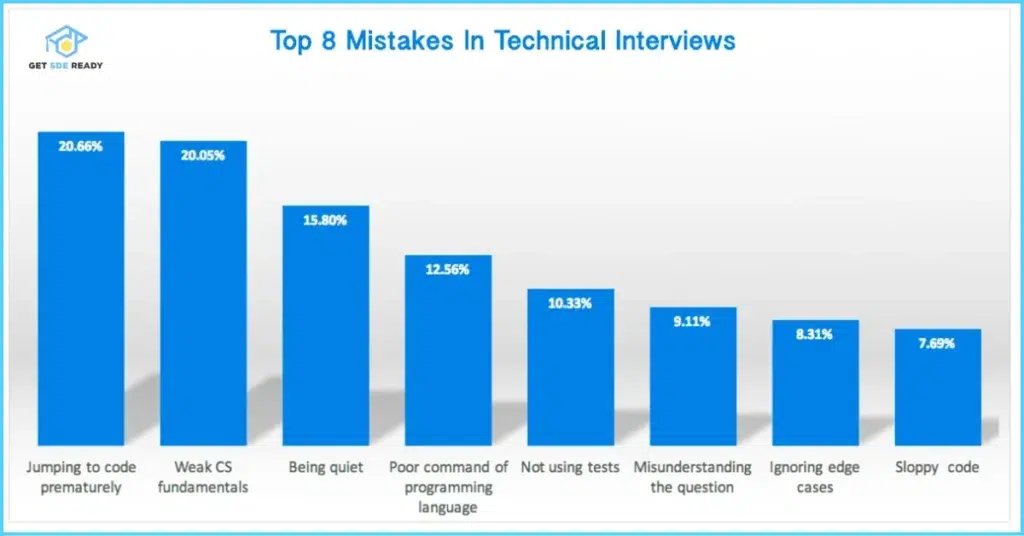
How to Avoid It
Take 2-5 minutes at the start to ask targeted questions:
- What are the input and output formats?
- Are there any constraints on time or space?
- Can inputs be null, empty, or negative?
Restate the problem in your own words to confirm understanding. This shows interviewers you’re thoughtful and methodical. Practice this with mock interviews – resources like our crash course include scenarios to hone this skill.
Real-World Example and Actionable Advice
Imagine a problem like “Implement a function to check if a string is a palindrome.” Without clarifying, you might ignore cases like ignoring punctuation or case sensitivity. A candidate who asks, “Should we consider case and non-alphanumeric characters?” can adjust accordingly, perhaps using a two-pointer approach while cleaning the string.
To practice, solve problems on platforms and force yourself to list 3-5 questions first. This habit alone can reduce errors by 50%, based on feedback from coding bootcamps.
Mistake 2: Lack of Communication During the Process
Silent coding is a killer in interviews. Many candidates focus so intensely on the code that they forget to verbalize their thoughts, leaving interviewers in the dark about their reasoning.
Why It’s a Mistake
Interviewers aren’t just evaluating your code; they’re assessing how you’d collaborate on a team. As a senior engineer at Uber shared in a video, “We care more about your thought process than the perfect solution – silence makes it impossible to evaluate that.” Data from Pramp’s analysis of technical interviews reveals that candidates who communicate poorly are rejected 3 times more often than those who talk through their approach.
Without narration, minor errors seem like major gaps in knowledge, and interviewers can’t provide helpful hints.
How to Avoid It
Adopt a “think aloud” strategy:
- Explain your initial brute-force idea, then optimize.
- Describe why you’re choosing a data structure (e.g., “I’m using a hash map for O(1) lookups”).
- If stuck, say, “I’m considering this approach, but I’m unsure about X – any thoughts?”
This builds rapport and demonstrates problem-solving skills. For those preparing for full-stack roles, our web development course emphasizes communication in coding challenges.
Real-World Example and Actionable Advice
In a “Two Sum” problem, instead of silently writing code, say: “First, I’ll iterate through the array and store complements in a map. This way, if I find a match, I can return indices immediately.” This transparency helped one Reddit user turn a potential fail into a hire.
Record yourself practicing and review for clarity. Aim to speak 60% of the time during coding.
Mistake 3: Ignoring Edge Cases and Not Testing Code
Overlooking edge cases is a classic pitfall, often because candidates get tunnel vision on the “happy path” and forget unusual inputs.
Why It’s a Mistake
Edge cases reveal how robust your code is. AlgoCademy’s blog highlights that neglecting them is among the top errors, causing 40% of solutions to fail in interviews. A recruiter on LinkedIn noted, “If your code crashes on an empty array, it shows lack of foresight – something we can’t afford in production.”
Without testing, bugs go unnoticed, turning a strong solution weak.
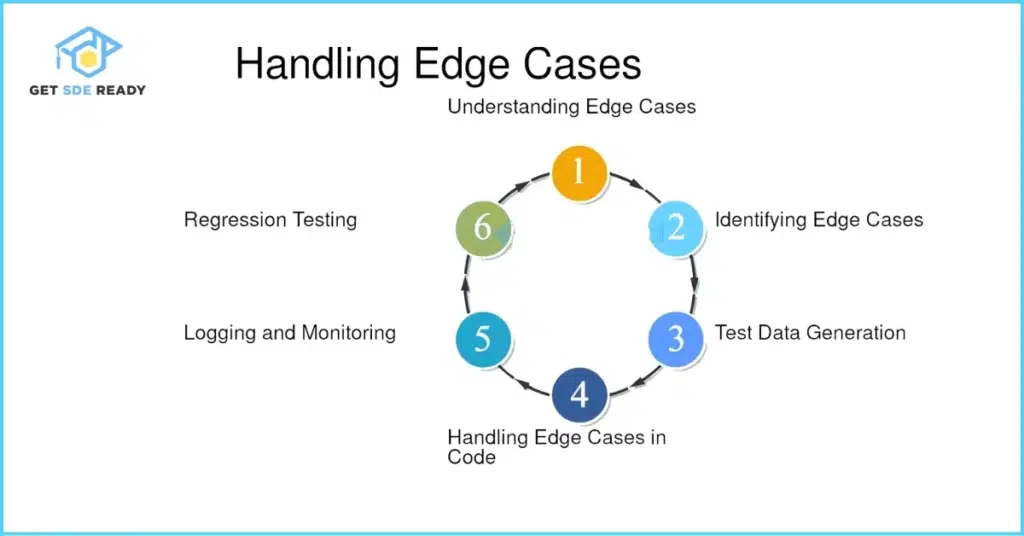
How to Avoid It
Systematically list edge cases:
- Empty or single-element inputs.
- Maximum/minimum values (e.g., INT_MAX).
- Duplicates or invalid data.
After coding, walk through 3-5 test cases verbally. If time allows, dry-run the code. Our master DSA, web dev, and system design course includes edge case drills for comprehensive prep.
Real-World Example and Actionable Advice
For “Merge Two Sorted Lists,” test with one empty list: the result should be the other list. Failing this is common but avoidable by asking, “What if one list is empty?”
Incorporate testing into your routine – it can increase success rates by 30%, per coding interview stats.
Mistake 4: Neglecting Time and Space Complexity
Many candidates deliver a working solution but forget to analyze its efficiency, missing a key evaluation criterion.
Why It’s a Mistake
Big tech companies deal with massive data, so scalability matters. Design Gurus reports that ignoring complexity leads to rejections in 25% of cases where code otherwise works. An expert from Codeforces warns, “Brute force might pass small tests, but it fails at scale – always optimize.”
This mistake signals inexperience with real-world constraints.
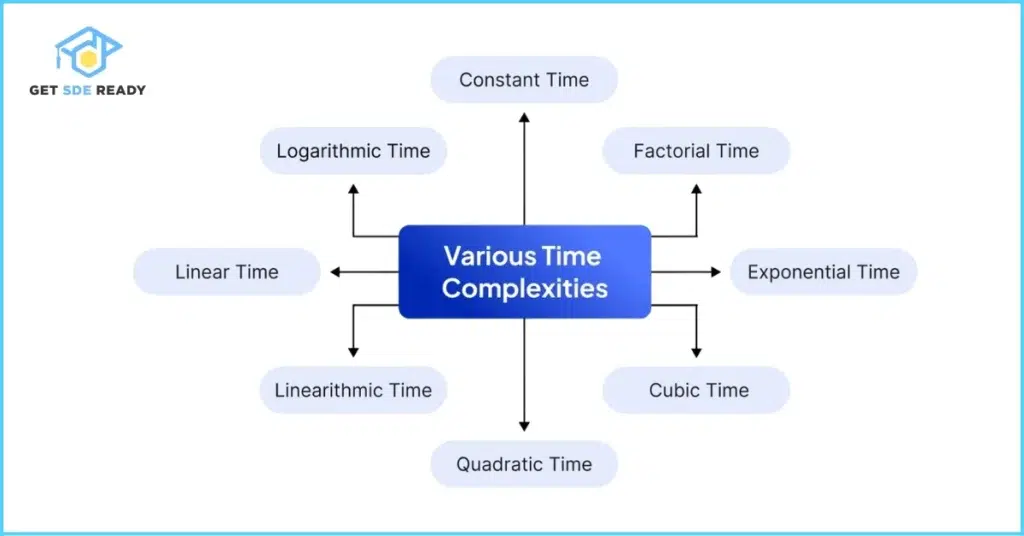
How to Avoid It
After planning, estimate complexity:
- Time: O(n log n) vs. O(n^2).
- Space: Discuss trade-offs, like using extra memory for speed.
If suboptimal, propose improvements. For data science roles involving algorithms, check our data science course.
Real-World Example and Actionable Advice
In “Sort an Array,” bubble sort (O(n^2)) is fine for small n, but mention quicksort for better average case. Practice calculating Big-O for every problem.
Mistake 5: Poor Time Management
Running out of time is devastating, often from over-planning or getting stuck on one part.
Why It’s a Mistake
Interviews are timed (45-60 minutes), and incomplete solutions hurt scores. GeeksforGeeks notes this affects 50% of candidates. A Reddit user shared, “I spent 20 minutes on edge cases and had no time to code – lesson learned.”
It prevents showcasing your full abilities.
How to Avoid It
Allocate time wisely:
- 5 mins: Understand/clarify.
- 10 mins: Plan/outline.
- 20 mins: Code/explain.
- 10 mins: Test/optimize.
If stuck, move to a partial solution. Use timed mocks from our crash course.
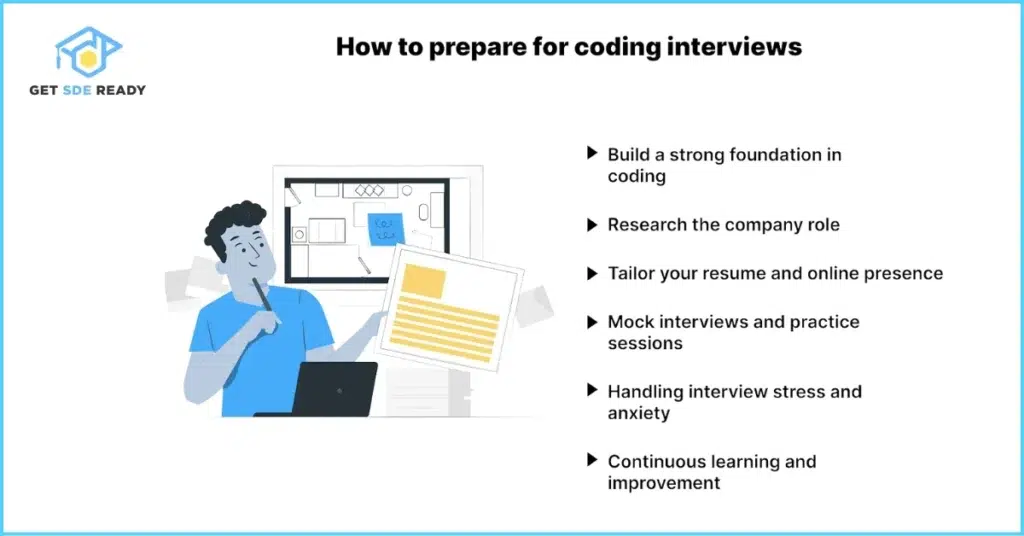
Real-World Example and Actionable Advice
In a graph traversal problem, prioritize BFS implementation first, then optimize. Track time during practice to build intuition.
Conclusion: Turn Mistakes into Strengths
Avoiding these top 5 mistakes – not clarifying problems, poor communication, ignoring edge cases, neglecting complexity, and time mismanagement – can transform your coding interview performance. Remember, preparation is key, and with the right mindset, you’ll not only solve problems but impress interviewers.
Ready to level up? Explore our courses for targeted practice. What’s one mistake you’ve made, and how will you fix it? Share in the comments, and don’t forget to sign up for free updates to stay prepared.
FAQs
What is the most common mistake in coding interviews?
The most frequent error is not clarifying the problem, leading to incorrect solutions; always ask questions to understand constraints and inputs.
How can I improve communication in technical interviews?
Practice thinking aloud during mock sessions, explaining your approach step-by-step to demonstrate problem-solving skills effectively.
Why are edge cases important in software engineering interviews?
Edge cases test code robustness; ignoring them, like empty inputs, can cause failures and show lack of thoroughness in coding assessments.
What role does time complexity play in avoiding interview pitfalls?
Analyzing time and space complexity ensures scalable solutions; discuss optimizations to highlight efficiency in developer job interviews.
How to manage time better during programming interview prep?
Allocate specific minutes for planning, coding, and testing; use timed practice to avoid common errors in high-pressure tech interviews.

DSA, High & Low Level System Designs
- 85+ Live Classes & Recordings
- 24*7 Live Doubt Support
- 400+ DSA Practice Questions
- Comprehensive Notes
- HackerRank Tests & Quizzes
- Topic-wise Quizzes
- Case Studies
- Access to Global Peer Community
Buy for 52% OFF
₹25,000.00 ₹11,999.00
Accelerate your Path to a Product based Career
Boost your career or get hired at top product-based companies by joining our expertly crafted courses. Gain practical skills and real-world knowledge to help you succeed.
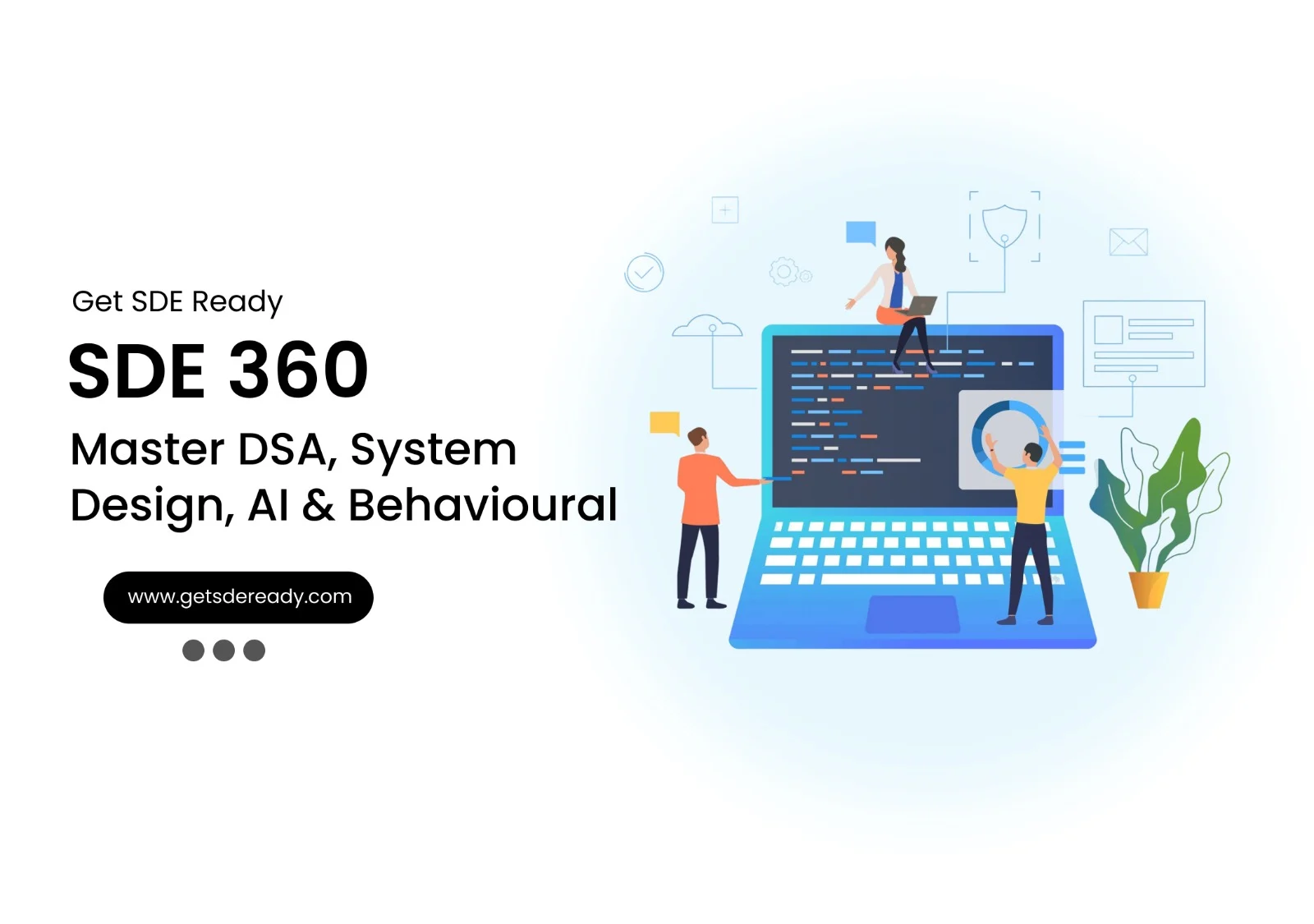
SDE 360: Master DSA, System Design, AI & Behavioural
- 100+ Live Classes & Recordings
- 24*7 Live Doubt Support
- 400+ DSA Practice Questions
- Comprehensive Notes
- HackerRank Tests & Quizzes
- Topic-wise Quizzes
- Case Studies
- Access to Global Peer Community
Buy for 50% OFF
₹39,999.00 ₹19,999.00

DSA, High & Low Level System Designs
- 85+ Live Classes & Recordings
- 24*7 Live Doubt Support
- 400+ DSA Practice Questions
- Comprehensive Notes
- HackerRank Tests & Quizzes
- Topic-wise Quizzes
- Case Studies
- Access to Global Peer Community
Buy for 52% OFF
₹25,000.00 ₹11,999.00
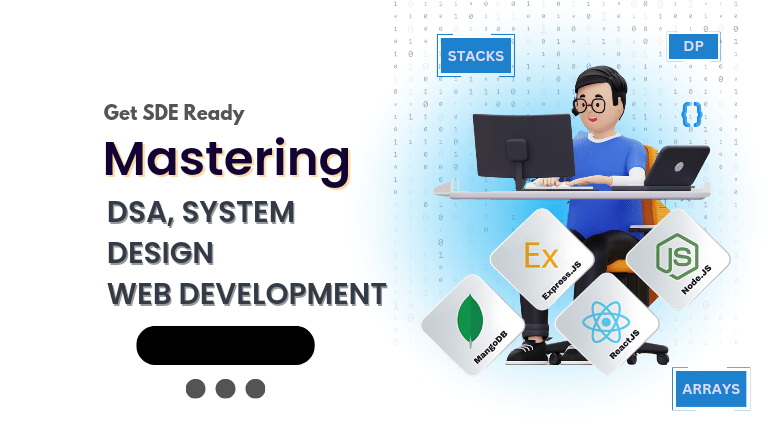
Fast-Track to Full Spectrum Software Engineering
- 120+ Live Classes & Recordings
- 24*7 Live Doubt Support
- 400+ DSA Practice Questions
- Comprehensive Notes
- HackerRank Tests & Quizzes
- 12+ live Projects & Deployments
- Case Studies
- Access to Global Peer Community
Buy for 51% OFF
₹35,000.00 ₹16,999.00
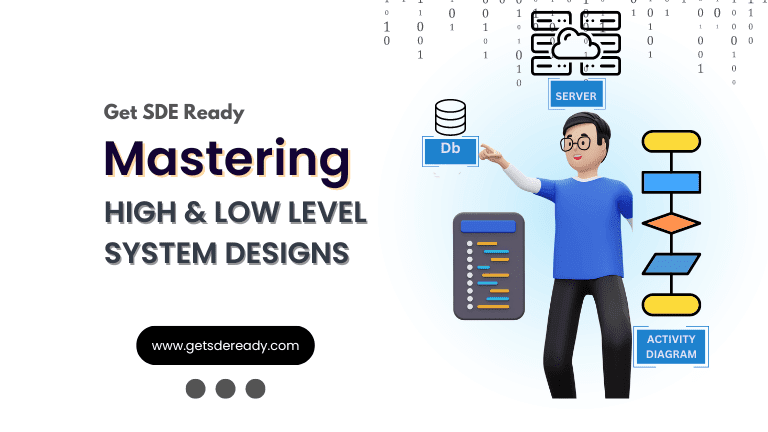
Low & High Level System Design
- 20+ Live Classes & Recordings
- 24*7 Live Doubt Support
- Case Studies
- Comprehensive Notes
- HackerRank Tests
- Topic-wise Quizzes
- Access to Global Peer Community
- Interview Prep Material
Buy for 60% OFF
₹20,000.00 ₹7,999.00
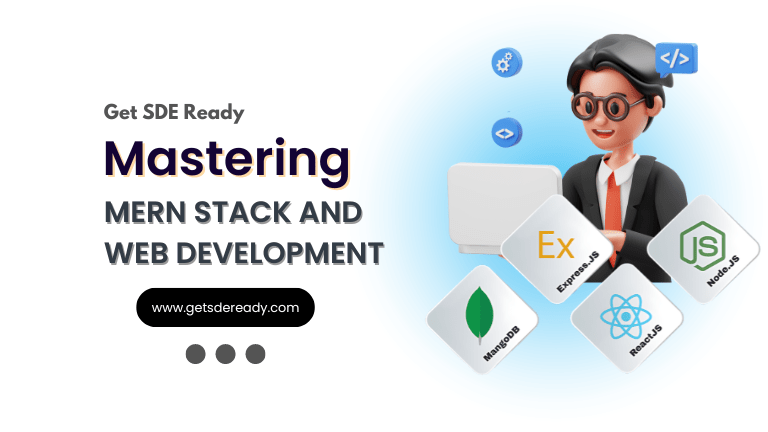
Mastering Mern Stack (WEB DEVELOPMENT)
- 65+ Live Classes & Recordings
- 24*7 Live Doubt Support
- 12+ Hands-on Live Projects & Deployments
- Comprehensive Notes & Quizzes
- Real-world Tools & Technologies
- Access to Global Peer Community
- Interview Prep Material
- Placement Assistance
Buy for 53% OFF
₹15,000.00 ₹6,999.00
Reach Out Now
If you have any queries, please fill out this form. We will surely reach out to you.
Contact Email
Reach us at the following email address.
arun@getsdeready.com
Phone Number
You can reach us by phone as well.
+91-97737 28034
Our Location
Rohini, Sector-3, Delhi-110085
